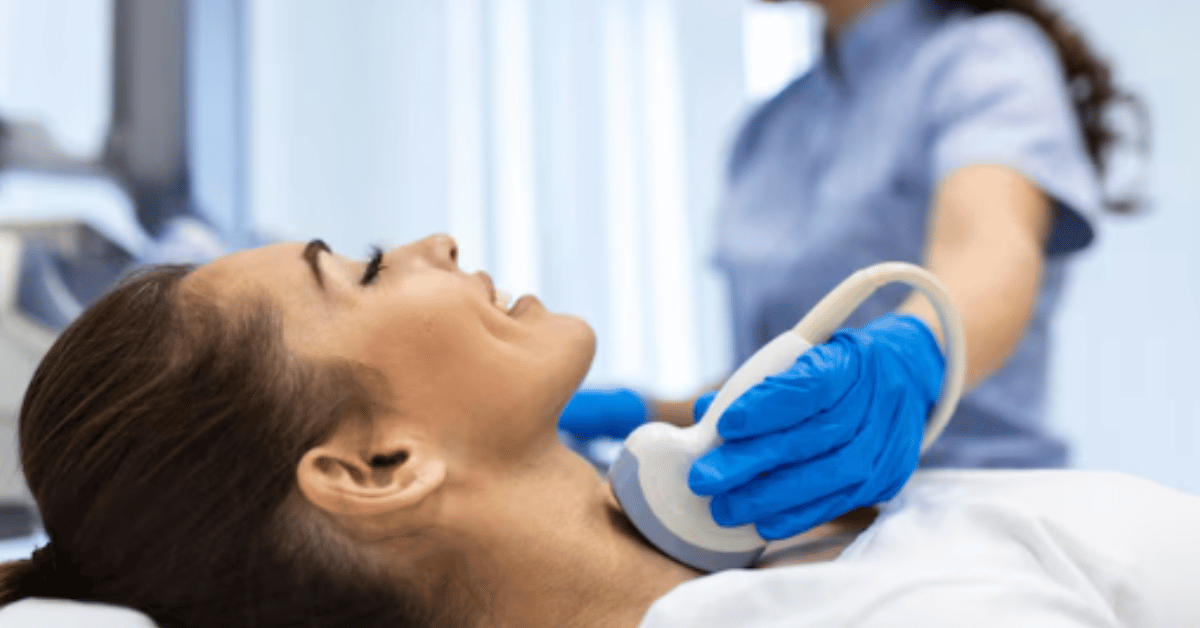The USG neck test, often referred to as a neck ultrasound, is a non-invasive imaging technique used to examine structures within the neck such as the thyroid gland, lymph nodes, salivary glands, and surrounding tissues. In simple terms, this test helps detect abnormalities like thyroid nodules, cysts, infections, enlarged lymph nodes, or even tumors. For someone experiencing swelling, persistent pain, difficulty swallowing, or visible lumps in the neck, a physician may recommend a USG neck test as the first diagnostic step. Unlike more invasive procedures, it does not use radiation and is generally safe for all ages, including children and pregnant women. The key reason people seek clarity on this test is to understand what it is used for, how it is performed, and what results may indicate. This article will provide a complete and updated perspective on the USG neck test, answering common concerns with detailed explanations. By the end, readers will have a clear sense of why doctors prescribe it, what preparation is necessary, how results are interpreted, and what follow-up steps may be required. As one radiologist put it, “Ultrasound of the neck is the window through which many hidden conditions first come into view.”
What is the USG Neck Test?
The USG neck test is a diagnostic imaging technique that uses high-frequency sound waves to create real-time images of the soft tissues in the neck. Unlike X-rays or CT scans, this procedure does not expose patients to ionizing radiation, making it safer for repeated use if necessary. The test is especially valuable because it can differentiate between solid and fluid-filled structures, a key distinction when evaluating lumps or cysts. It provides doctors with immediate information about the size, shape, texture, and blood supply of neck tissues. Because it is painless and widely available, the USG neck test is often the first-line investigation before recommending further imaging such as MRI or biopsy. Many patients arrive with anxiety, unsure if the swelling in their neck is serious. This test offers both reassurance and direction, guiding physicians toward targeted treatments. As medical specialists often remark, “A neck ultrasound rarely gives all the answers, but it often gives the most important first clue.”
Why is the USG Neck Test Done?
Doctors recommend the USG neck test for multiple clinical reasons. The most common is to evaluate the thyroid gland, which can develop nodules, cysts, or goiters. In addition, this test is used to investigate enlarged lymph nodes that may result from infections, autoimmune conditions, or malignancies. It can also assess salivary glands for blockages or stones and detect vascular changes in the neck. For individuals with symptoms like persistent sore throat, difficulty swallowing, unexplained swelling, or voice changes, the ultrasound provides vital insights. In oncology, it helps track the spread of cancers in the neck region and monitor treatment response. Beyond clinical disease, it is also used in follow-up for post-surgical patients, ensuring no abnormal regrowth or recurrence. Importantly, physicians rely on this imaging tool not only for diagnosis but also as a guide during fine needle aspiration biopsies, ensuring accuracy and safety. Patients are often surprised by how quickly this test can distinguish between benign and suspicious findings, saving time and unnecessary stress.
The Procedure of the USG Neck Test
The procedure is simple, usually lasting between 15 and 30 minutes. The patient lies on an examination table with their neck slightly extended. A water-based gel is applied to the skin to improve sound wave transmission, and a handheld probe called a transducer is gently moved across the neck. The images are displayed on a screen in real time, allowing the radiologist to examine each area carefully. In most cases, no discomfort is felt beyond the cool sensation of the gel. For some patients, mild pressure may be experienced if the area is tender. No sedation or special equipment is required, and patients can return to their normal activities immediately afterward. Unlike MRI or CT scans, there is no need for contrast dyes or injections, which reduces the risk of allergic reactions. The non-invasive and quick nature of the test makes it one of the most patient-friendly imaging methods. Parents of young children often find relief knowing the procedure is painless, while older adults appreciate the simplicity and efficiency of the process.
Preparation for the USG Neck Test
One of the advantages of this test is minimal preparation. Patients are usually advised to wear loose clothing, ideally with an open neckline, to make access easier. No fasting or medication adjustments are typically needed. Jewelry, necklaces, or scarves should be removed before the procedure to avoid interference. In rare cases, if the ultrasound is part of a larger diagnostic protocol, doctors may give specific instructions such as avoiding certain creams or lotions on the neck area. For children, parents may be encouraged to bring comfort items or distractions since staying still improves image quality. Because the test involves no radiation, pregnant women do not require additional precautions, making it safe for prenatal diagnostic purposes. The ease of preparation is often what makes this test so accessible, ensuring it can be scheduled quickly even in urgent situations. For most individuals, the greatest preparation lies in reducing anxiety, and reassurance from healthcare providers plays a central role in this regard.
Interpreting the Results
Results from a USG neck test are typically available within hours to a day, depending on the facility. Radiologists analyze the images for abnormalities in shape, size, echogenicity, and vascularity of tissues. A thyroid nodule, for example, may be classified as solid, cystic, or mixed, with further notes on irregular margins or calcifications. Lymph nodes are assessed for symmetry, size, and internal structure. Benign findings often include smooth, oval-shaped nodes or fluid-filled cysts, while malignant signs may show irregular, hypoechoic regions with increased blood flow. Based on the findings, the report is shared with the referring physician, who explains the next steps to the patient. Sometimes the ultrasound alone provides sufficient information, while in other cases, further evaluation such as biopsy or CT scan is recommended. Patients should remember that not all suspicious results confirm cancer; many variations turn out to be harmless. As one clinician summarized, “An ultrasound is like a flashlight—it shows what’s there, but interpretation is the real key.”
Benefits of the USG Neck Test
The benefits of the USG neck test extend beyond simple diagnosis. First, it is non-invasive, painless, and safe for repeated use. Second, it provides real-time imaging, allowing doctors to make immediate assessments or guide procedures like biopsies. Third, it can detect small abnormalities that might be missed on a physical exam, especially in deeper tissues. Fourth, it is cost-effective compared to other imaging modalities, making it accessible to a wider patient population. Moreover, because it does not involve radiation or contrast, it is suitable for patients with chronic conditions requiring long-term monitoring. Another overlooked benefit is patient reassurance; many individuals walk away from the test with peace of mind knowing whether their concern is benign. For doctors, the test is an invaluable tool that bridges the gap between suspicion and certainty, offering clarity where symptoms alone fall short.
Risks and Limitations
While the USG neck test is considered safe, it has limitations that patients should understand. It cannot always differentiate between benign and malignant nodules without further testing. Deeper structures, particularly those behind bone or air-filled cavities, may not be fully visible. Operator skill also plays a significant role; the quality of results can vary depending on the technician or radiologist. Furthermore, ultrasound findings often require correlation with blood tests, biopsies, or other imaging studies for a complete diagnosis. Although there are no known risks from sound waves themselves, inaccurate interpretation may lead to unnecessary anxiety or additional procedures. Patients should therefore choose experienced diagnostic centers where interpretation is thorough and explained clearly. While the test is highly useful, it is not definitive in isolation. Recognizing these limitations ensures patients maintain realistic expectations and follow medical guidance for comprehensive care.
Table 1: Common Reasons for a USG Neck Test
| Reason for Test | Explanation | Typical Symptoms |
|---|---|---|
| Thyroid nodules | Detects cysts or solid growths in thyroid gland | Neck lump, voice changes, swallowing difficulty |
| Enlarged lymph nodes | Evaluates cause of swelling | Persistent sore throat, infections, unexplained swelling |
| Salivary gland issues | Identifies stones or blockages | Painful swelling, dry mouth, recurrent infections |
| Cancer staging | Monitors spread of tumors | Lump, weight loss, systemic symptoms |
| Post-surgery follow-up | Checks recurrence of conditions | Routine monitoring after thyroid or neck surgery |
Cost and Accessibility
The cost of the USG neck test varies depending on location, facility, and whether it is part of a broader diagnostic package. In most urban centers, the test is relatively affordable compared to CT or MRI scans. Many insurance providers cover it when prescribed by a doctor. In community clinics, the test is sometimes subsidized, ensuring accessibility to wider populations. Patients should inquire in advance about cost transparency, especially if additional procedures like biopsy may follow. Accessibility is another strength—because the equipment is widely available, even smaller hospitals and diagnostic centers often offer the test. For individuals living in rural areas, mobile ultrasound units have made it easier to bring this diagnostic tool closer to communities. Affordability and accessibility together reinforce why the USG neck test remains one of the most frequently ordered diagnostic procedures across healthcare systems worldwide.
Table 2: Advantages and Limitations of the USG Neck Test
| Aspect | Advantages | Limitations |
|---|---|---|
| Safety | No radiation, safe for children and pregnant women | Cannot visualize behind bone or air spaces |
| Accuracy | Detects nodules, cysts, and vascular changes | Cannot always confirm malignancy without biopsy |
| Cost | Affordable compared to other imaging | Price may vary by facility |
| Accessibility | Widely available across hospitals and clinics | Quality depends on operator skill |
| Convenience | Quick, painless, no fasting required | May require further tests for confirmation |
Conclusion
The USG neck test has become one of the most essential diagnostic tools in modern medicine, bridging the gap between suspicion and clarity. For patients, it offers reassurance through a quick, painless, and safe procedure that reveals critical details about thyroid, lymph nodes, and other neck structures. For doctors, it provides the first line of evidence before recommending further interventions. Despite its limitations, its benefits in terms of accessibility, affordability, and safety outweigh drawbacks. Patients should understand that while the ultrasound provides valuable insights, it is part of a broader diagnostic puzzle that may include blood tests, biopsies, and other imaging. As one experienced physician reflected, “Every scan tells a story, but it takes both technology and judgment to interpret its meaning.” In a time where early detection defines treatment outcomes, the USG neck test stands as a frontline defender of health, quietly guiding both doctors and patients toward informed and timely care.
FAQs
Q1. What is the USG neck test mainly used for?
The USG neck test is primarily used to examine the thyroid gland, lymph nodes, salivary glands, and soft tissues of the neck. It helps detect abnormalities such as nodules, cysts, infections, blockages, or even tumors. Doctors recommend it when patients present with neck swelling, pain, lumps, or difficulty swallowing.
Q2. Is the USG neck test painful?
No, the procedure is completely painless. A water-based gel is applied to the skin, and a handheld probe is moved gently over the neck. Some patients may feel slight pressure if the neck area is tender, but overall the test is comfortable and non-invasive.
Q3. Do I need to prepare before going for a USG neck test?
Minimal preparation is required. Patients should wear loose-fitting clothes with an open neckline for easy access. No fasting or special dietary restrictions are needed. Removing jewelry or accessories around the neck is usually the only requirement.
Q4. How long does it take to get the results?
The test itself usually takes 15–30 minutes, and results are often available within hours or by the next day. The radiologist reviews the images and prepares a report, which is then shared with your doctor for interpretation and follow-up.
Q5. Can the USG neck test detect cancer?
The USG neck test can detect suspicious features such as irregular nodules, unusual lymph nodes, or abnormal blood flow patterns. However, it cannot confirm cancer on its own. If something concerning is found, your doctor may recommend further tests such as fine needle aspiration biopsy or CT/MRI for confirmation.











